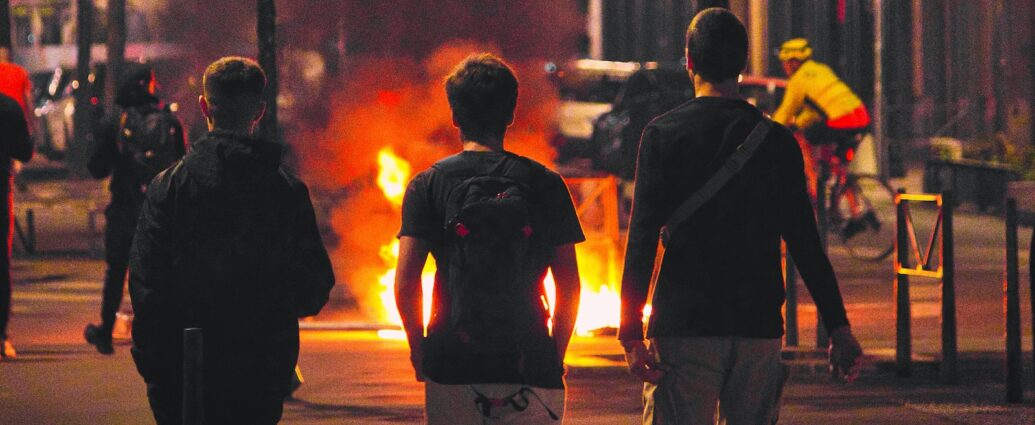Nellie Monneret
French suburbs have been the centre of riots and civil unrest in recent weeks following the shooting of 17-year-old Nahel Merzouk by police. However, this is not France’s first bout of civil unrest. These riots fundamentally highlight the discontentment among many working class civilians.
Riots sparked after Merzouk, a French citizen of Algerian and Moroccan descent, was shot dead on Tuesday 27 June at point blank range by a policeman. Merzouk was driving away from police in Nanterre at the time. According to French authorities, the teenager was driving without a license and refused to obey police orders during a traffic stop. Prosecutors have since ruled that the use of a firearm by police in this situation was not legally justified. The police officer involved is now under formal investigation for voluntary homicide.
President’s Response
To try to calm the quickly rising riots, French president Emmanuel Macron publicly condemned the shooting, declaring it “inexplicable”. When the situation grew out of control in several big cities, President Macron held cabinet crisis meetings in an attempt to regain control. A high number of police officers were deployed to rioting suburbs, which exacerbated matters due to the existing tension between law enforcement and locals.
During the two weeks of daily unrest, over 5,000 cars and 1,000 buildings were damaged and almost 4,000 people arrested. Most of those arrested were under the age of 25 and previously unknown to the police force. Hundreds of police stations and official buildings were targeted by rioters, leaving many police officers wounded.
This might not be the first outbreak of rioting in French suburbs, however according French newspaper Le Monde, the recent wave of unrest has spread more widely across the country than previous civil disturbances.
France’s History of Civil Unrest
Riots previously occurred in 2005 after two boys died of electrocution in an electrical substation in Clichy-sous-Bois (an eastern suburb of Paris). Zyed Benna and Bouna Traoré were hiding from police during the investigation of a reported break-in at a building site. The riots lasted three weeks and an emergency state was declared for a period of three months. The incident sparked a nation-wide debate on unemployment and police intervention in working class districts.
“We often hear researchers and politicians speak about these suburbs, but we never hear from the young people who live there.”
Following the 2005 riots, local authorities invested in new infrastructures, transport lines, and social projects with the intention of developing the suburbs and creating more opportunities for residents. Despite these efforts, general resentment and fear towards the banlieues (suburbs) grew and occasional eruptions of street and gang violence persisted.
Jeanne Demoulin, a lecturer in education sciences at the University Paris Nanterre and researcher on working class districts, has said that the situation won’t improve easily. She explains: “We’ve had this issue of daily, routine violence in working class districts for decades in France. People living in these places are still considered as ‘separate citizens’ rather than fully-fledged citizens.”
“We don’t speak much about our colonial past and stories that have marked generations of immigrants.”
Demoulin continues: “Young people in the suburbs don’t have space for dialogue. We often hear researchers and politicians speak about these suburbs, but we never hear from the young people who live there.”
Systemic Discrimination
According to Demoulin, people from certain suburbs are subject to both acts of “ordinary discrimination” – such as random police checks – and “institutional discrimination”, which affects them when they try to access higher education, new accommodation, or career prospects.
“For me, our Republic is colour-blind, and we do not acknowledge the different cultures within our country. We don’t speak much about our colonial past and stories that have marked generations of immigrants,” Demoulin adds.
Amid the beginning of the riots on 28 June, EU justice commissioner, Didier Reynders, said the “very high level of violence” in recent years in France, including during protests like the yellow vests, is “striking”.
In response to these comments, France’s minister of European affairs, Laurence Boone, told French radio RFI that the commissioner had “overstepped the mark”. She argued that this issue wasn’t specific to France, comparing it to the 2011 England riots. Boone says: “Look at the 2011 riots in England, which were triggered by a similar tragedy and also happened a year before the Olympic Games. We’ve observed the same thing in Denmark and Sweden too.”
On 7 July, the UN’s Committee on the Elimination of Racial Discrimination (CERD) urged France to address its issues of “structural and systemic racial discrimination”. In a communique published the next day, the French ministry for Europe and Foreign Affairs stated that these accusations were “unfounded”. They also deplored a “lack of solidarity and compassion” towards representatives targeted in the attacks.
Hope for the future
Demoulin comments: “I think the responsibility lies in the successive governments and the way they have given more power to the police, which has itself become more violent and has been allowed to use war weapons.”
“We need to build a social cohesion and stop any divisive speech and actions that will lead to the next riots.”
“There is also a general issue with the training of workers in these areas. For example, some teachers are sent there without any proper training, and it becomes difficult for them to deal with. It is the same with young policemen who come from rural areas and are sent in the density and social distress of the working-class districts.”
When asked if there is still hope for the future, Demoulin answered: “We need to build a social cohesion and stop any divisive speech and actions that will lead to the next riots.”
READ NEXT:
-
IS FRANCE STILL A CHAMPION OF PROTEST RIGHTS?
-
RIOTS CONTINUE IN FRANCE
-
MILLIONS STRIKE IN FRANCE AS MACRON CONTINUES TO BACK PENSION REFORM BILL
Featured image courtesy of Vegonaise on Unspalsh. No changes were made to this image. Image liscense found here.

